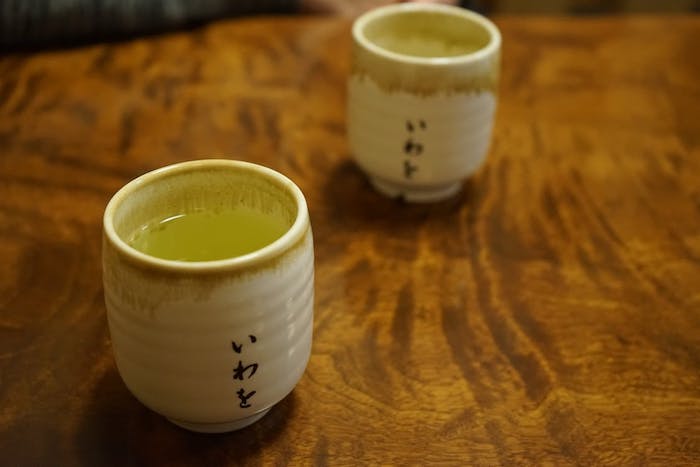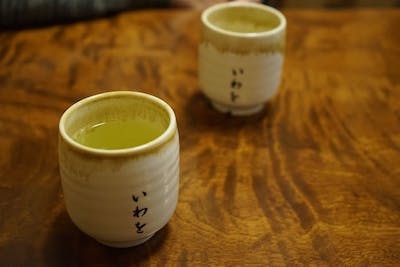We are reader supported. When you purchase through links on our site, we may earn an affiliate commission. Also, as an Amazon affiliate, we earn from qualifying purchases.

After reading our blog you now know all the details about sushi and how to eat it. But what about drinks with sushi? Of course, besides sake, the usual drink is tea. But have you ever wondered what is a typical tea served at sushi restaurants?
The typical tea you will get in any sushi restaurant is – mild green tea. It can be konacha, gyokuro or sencha. Forget about sake or anything other like a glass of water. Choosing from one of these hot green teas, you will not go wrong. They will complement your sushi bites just perfectly and make you enjoy in your sushi even more.
Moreover, tea is considered to be one of the main aspects of Japanese culture so it is not surprising that it goes well with sushi. If you are now intrigued by these tea revelations, read on and find out all about tea varieties served at sushi restaurants.
What tea should you drink with sushi
As you know, sushi is a meal that is quite salty and your mouth will demand something to fill its thirst. That’s where tea comes in. And it cannot be just any tea. Hot green tea is a must when you eat sushi in any good sushi restaurant across the world.
The traditional tea, that you are given for free, is called konacha (see Amazon). This tea is made from the leaf leftovers when you process teas like sencha or gyokuro. It may surprise you that this green tea is not the superior one like for example sencha, while konacha is actually made out of the leftovers.
Konacha taste is mild to bitter and it complements the sushi taste very well. The tea serves as a refresher to prepare your tongue for the next sushi bite and not to take away your attention from food. That’s why it is not so surprising that high-quality teas are not served with sushi.
High-quality teas like sencha or gyokuro (see Amazon) are considered to be a casual drink on its own and they are not suited for drinking when eating sushi. Nevertheless, some sushi restaurants also served them, but the traditional one that you should drink with sushi is konacha.
The tea you will be served in sushi restaurants is extremely hot, so be careful. The hotness of the tea serves for cleaning your tongue and removing any taste of fish so you are ready for new sushi adventures.
Each and every one piece of sushi has a unique and delicate taste so it is mandatory to refresh your senses. Sushi has an oily and gentle flavor and it cannot be fully appreciated if you have the taste from the last sushi bite. By drinking a fresh and hot cup of green konacha tea you will be prepared to enjoy the flavor of the next sushi piece.
What other green tea can you drink
Even though you will most likely drink konacha tea in any ordinary sushi restaurant, some of them have different tea options. At some sushi restaurants, you can also choose teas like sencha, genmaicha or gyokuro, that will also go well with the sushi aroma. Their grassy flavors will be a great foundation for eating sushi.
So, what are the differences between these types of green tea?
• Sencha
Sencha is one of the most common types of green tea in Japan and it balances with sushi flavors really well. It is produced from both the first and the second flushes of the tea leaves and it has a strong and rich flavor that will complement your salty sushi perfectly.
How to make it: Dosage: 3–5 grams, Time: 1 minute, Water: 1 cup at 158°F (70°C).
• Genmaicha
Genmaicha tea is made from roasted brown rice mixed with tea leaves. It is very common in sushi restaurants and it goes well with fattier sushi like toro sushi. It is more bitter and heavier than sencha so don’t let it steep for too long for maximum enjoyment with sushi.
How to make it: Dosage 3–5 grams, Time: 1 minute, Water: 1 cup at 176°F (80°C).
• Gyokuro
Gyokuro tea is considered to be a high-quality and expensive range of tea. This tea is commonly served in high-end sushi restaurants and it goes well with sushi that is high in umami – like fugu sushi. And if you want your tea to be mild and without bitterness then you got yourself a winner – gyokuro.
How to make it: Dosage: 5 grams, Time: 2–3 minutes, Water: 1/3 of a cup at 122°F — 140°F (50°C — 60°C).
These types of green tea will go so good with your sushi that you will not want to drink anything else with your meals! Next time you are visiting a sushi restaurant you will be well prepared on which green tea to drink.
Green tea in Japanese culture
Green tea is the most popular type of tea in whole Japan and it has been part of the Japanese culture since the 9th century when it was brought over from China.
The importance of green tea in Japan is clearly expressed in the oldest Japanese traditions – the tea ceremony. The tea ceremony has been affected by Zen Buddhism and it is, in fact, a ceremonial way of preparing and drinking green tea typically in a traditional tearoom.
Even today, green tea is a heavy part of most Japanese people’s life. Almost every meal in Japan is accompanied by a fresh pot of green tea. Green tea is more than just tea, is a way of life and hospitality in the whole Japanese culture.
Green tea is consumed several times in a day and most restaurants in Japan will offer free tea with meals – since it’s such an important part of the dining culture. Something like when you get water for free in any Western restaurant.
Moreover, the subtle and kind of grassy flavors of green tea are delicious but also healthy! It is said that green tea has numerous health benefits such as vitamin C, antioxidants and helps with digestion. That’s why it’s an excellent drink to keep sipping every day.
Green tea is different from black and any other type of them in how the leaf is cultivated and ultimately processed. Although they come from the same plant called Camellia sinensis the processing is different. Green tea is processed quickly to prevent the oxidation by steaming right after being harvested and that is why black tea is stronger and darker than green tea.
The various types of green tea depend on different cultivating methods and well as the different steaming and drying process. The most popular green tea in Japan is Sencha and is grown throughout Japan.
However, other grades of green tea such as gyokuro are grown exclusively in the Kyoto region. This area is where the Japanese tea ceremony was first established and it is therefore often referred to as the birthplace of Japanese tea culture.
The varieties of green tea are absolutely amazing – each version having its one flavor and aroma makes it perfect for pairing with different food. Even if usually sushi is paired with sake, drinking green tea makes it more interesting. Each variety of green tea can highlight the particular flavor of the sushi.
Related Questions
Can you drink a floral tea with sushi?
To state it simply: No! As you already know, the tea should not have an overpowering aroma that will dominate the sushi. So, never choose any floral or sweet tea aroma teas such as jasmine tea. Stick to the good old green tea, such as konacha, sencha or genmaicha. They will complement your sushi meal perfectly.
What is the best way to drink green tea?
In order to fully enjoy your green tea, you need to follow a few simple steps when making it:
• Watch on the temperature! The ideal temperature for making green tea should be from 160-180 ºF (70-82 ºC). One of the most common mistakes when making a pot of green tea is steeping it with boiling water.
• Be careful about the steeping time. Steeping time is not the same for all green teas and it depends on the type and quality of the green tea you use. In general, you can’t go wrong by steeping for three minutes and then check if the taste is how you prefer it.
• As much as the quality of tea is important so is the quality of your water. If you have a chance use mountain spring water or high-quality bottled water. This will determine how your green tea will taste.
• Keep it simple – green tea is best on its own without sugar, dairy, or anything else added in it.

